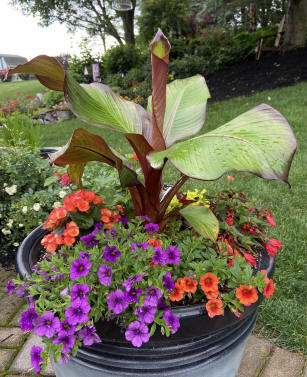 (6/20) Tropical plants are native to warm, humid, frost-free zones; however, they can provide beauty to Pennsylvania gardens during the summer months and be a welcome addition in your home in the winter. The Banana plant has become a common patio planting. My love for a banana plant occurred unintentionally when I was given a beautiful container of assorted specialty annuals for a birthday gift. The "thriller" in this container appeared to be a canna lily. When I read the tags of the plants, I was pleasantly surprised to see that it was Abyssinian Ornamental Banana (Ensete). It served well in the summer as an accent plant among the other annuals. In the fall, I removed the faded annuals in the container, and brought the container with the banana plant inside. After the other plants were no longer in the container and the banana plant was fertilized, it really
began to show off. So began my love of growing an indoor banana plant.
(6/20) Tropical plants are native to warm, humid, frost-free zones; however, they can provide beauty to Pennsylvania gardens during the summer months and be a welcome addition in your home in the winter. The Banana plant has become a common patio planting. My love for a banana plant occurred unintentionally when I was given a beautiful container of assorted specialty annuals for a birthday gift. The "thriller" in this container appeared to be a canna lily. When I read the tags of the plants, I was pleasantly surprised to see that it was Abyssinian Ornamental Banana (Ensete). It served well in the summer as an accent plant among the other annuals. In the fall, I removed the faded annuals in the container, and brought the container with the banana plant inside. After the other plants were no longer in the container and the banana plant was fertilized, it really
began to show off. So began my love of growing an indoor banana plant.
The banana family (Musaceae) consists of approximately 75 species. Many of these become excellent houseplants that don’t require an abundance of care. The banana family shares a number of traits with closely related species such as cannas, gingers, and birds-of-paradise. Banana is a lush, green, fast-growing plant that can create a stunning and tropical atmosphere. They are native to the tropical region of southeast Asia. While these tropical plants are commonly referred to as trees, they are actually huge herbaceous plants. Its trunk is a non-woody pseudostem made up of leaf stalks (petioles) that grow tightly bundled together. In Ethiopia, fibers harvested from the pseudostem are traditionally used for making mats and ropes. New leaves grow up from the center of the trunk, pushing older leaves outward. Under the ground, the base of a banana plant has a big rhizome or corm. This is the plant’s root system. Many varieties become excellent houseplants that
don’t require an abundance of care.
A Banana plant needs a deep and wide container to grow. Choose a sturdy pot at least 18-24 inches in depth and width. Depth is important to growing banana plants because the roots need plenty of space to expand. Banana plants love full sun, heat, and humidity. Place it in a location that receives sun most of the day but is sheltered from strong wind. Banana plants require well-draining soil. A good mixture is sand or perlite with compost. The soil pH should be in the range of 6 to 7. This plant may require watering every day but avoid waterlogging.
Banana requires heavy feeding to grow to its full potential. Feed young plants with a fertilizer rich in potassium, nitrogen, and magnesium. A banana plant can grow to 20 feet if not placed in a container. Some common pests to be aware of are Aphids, Red Spider Mites, and Thrips.
Avoid exposing your plant to a temperature below 50 degrees F. Relocate the plant indoors near a large window so that it can receive plenty of bright light. Do not expect the plant to produce fruit indoors because it needs tropical conditions for this to occur. The banana plant can be relocated outdoors when the temperature is consistently 50 degrees F.
While most species grow best in warm climates, there are some cold-hardy banana plants. They can be protected in the winter with mulch. It is important to choose a location where it will be sheltered from strong winds because it is susceptible to damaged leaves. Prepare the planting site by mixing some compost into the soil. Be mindful of allowing enough space for the height and spread of the particular species.
A banana plant is a welcome addition in the home because it contributes as an air purifier and creates an inviting, tropical atmosphere. The banana plant serves as a stunning accent on a patio or deck. With proper care, a banana plant can be enjoyed indoors and outdoors for years.